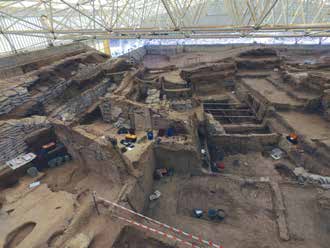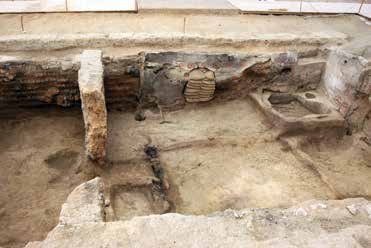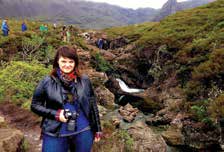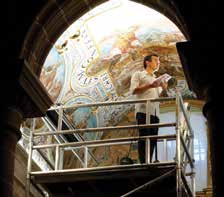November 1, 2016




The 9,000-year-old mudbrick structures at the site of .atalh.yük, located on the Konya plain in Turkey, are threatened by their own fragile composition and the region’s harsh climate. The site, a rare example of a well-preserved Neolithic settlement, was home to between 3,500 and 8,000 people from about 7100 to 6200 b.c. The houses in the streetless settlement were built back to back and accessed via the roofs. In 2012 the settlement was declared a World Heritage site because of its importance to understanding human development and social organization at a time when the first agricultural settlements were appearing in southern Anatolia. The site has also gained attention for its many symbolic and ritual artifacts, including wall paintings and reliefs.
The decay of the site’s mudbrick buildings can be attributed mainly to the region’s arid climate and erosion caused by high levels of soluble salts in the soil. To help combat the deterioration of the site, the AIA awarded its most recent Site Preservation Grant to the .atalh.yük Digital Preservation Project (CDPP). The CDPP, a collaboration between Nicola Lercari from the University of California, Merced’s World Heritage program and Ashley Lingle, head of conservation at .atalh.yük, proposes to use the vast amount of digital survey data collected from the site to create a strategy for monitoring and conserving the archaeological remains. The project will use digital technologies and current monitoring strategies to build a comprehensive view of the site in its current state and create an informed conservation plan for the future.
By combining current non-digital site monitoring data with digital documentation from environmental data loggers, terrestrial laser scanning, micro unmanned aerial vehicles, multispectral and thermal imaging, and GIS, the CDPP plans to develop predictive models that conservators can use to create preventive on-site interventions. The CDPP believes that its models will provide insights into problem areas that may otherwise have gone unnoticed and will also allow for the quantitative assessment of the success of earlier conservation efforts. In addition to its technical work, the CDPP will train students from SelНuk University in Konya and the Middle East Technical University in Ankara, as well as specialists from the Konya Archaeological Museum, to continue preservation work at the site after the CDPP wraps up in 2018.
The AIA and the CDPP believe that the methodology established at .atalh.yük can serve as a model to be emulated by projects at other sites that are working to protect and preserve large archaeological sites and those that contain earthen structures. To read more about this project and the AIA Site Preservation Program, visit www.archaeological.org/sitepreservation.
We invite you to join us at the 118th Joint Annual Meeting of the Archaeological Institute of America (AIA) and the Society for Classical Studies (SCS) in Toronto, Ontario, Canada, from January 5 to 8, 2017. The Annual Meeting brings together more than 3,000 professional and vocational archaeologists and classicists from around the world and nearly every state in the United States to share the latest developments from the field. The conference, the largest and oldest established meeting of archaeologists and classical scholars in North America, has grown tremendously over the past decade not only in terms of attendance, but also in the scope of papers presented, demographics of attendees, and focus on professional development, cultural heritage management, new technologies, and other topics of critical importance to the field. To find out more about the 2016 AIA-SCS Joint Annual Meeting visit www.archaeological.org/annualmeeting.
The AIA Museums and Exhibitions Committee awarded Elizabeth Bartman Museum Internship Fund scholarships to Alexis Jordan and Yiğit Helvaci. Jordan and Helvaci are the second set of recipients of the scholarship, which was established last year in honor of AIA Past President Elizabeth Bartman to assist graduate students or those who have recently completed a master’s degree with the expenses associated with participating in a museum internship either in the United States or abroad.
Jordan, a Ph.D. candidate in anthropology at the University of Wisconsin–Milwaukee, received her M.S. in anthropology from the same school and her B.S. in anthropology from Loyola University Chicago. The funds will allow her to spend eight weeks at the Royal Cornwall Museum in the United Kingdom conducting archival research and skeletal analyses on the remains from Harlyn Bay, the largest Iron Age cemetery in Cornwall. Her work will focus on the construction of cultural identities in the pre-Roman and Roman Iron Ages (800 b.c.–a.d. 400) in southwestern Britain through the analysis of mortuary ritual and human remains.
Helvaci completed his B.A. in classics at Istanbul University. He received his first M.A. degree in archaeology and art history from KoН University, Turkey, and his second in archaeological materials sciences from the University of Гvora, Portugal, and Sapienza University of Rome, Italy. Helvaci will intern at the Museum of Byzantine Culture in Thessaloniki, Greece, where he will create digital 3-D models of the museum collection using photogrammetry. All models that are created during his tenure will be made available on the museum website for public viewing.
The next deadline for applications for the Elizabeth Bartman Museum Internship Fund is April 1, 2017. To read about this and other AIA funding opportunities, please visit www.archaeological.org/grants.
 The 2017 “Year of Archaeology” calendar, featuring photos from the AIA Photo Contest, is now available. All proceeds from the sale of the calendar go directly to the AIA Site Preservation Program. Enjoy the beauty of archaeology all year long while you help the AIA preserve archaeological sites: Buy the calendar at www.archaeological.org/calendar.
The 2017 “Year of Archaeology” calendar, featuring photos from the AIA Photo Contest, is now available. All proceeds from the sale of the calendar go directly to the AIA Site Preservation Program. Enjoy the beauty of archaeology all year long while you help the AIA preserve archaeological sites: Buy the calendar at www.archaeological.org/calendar.
AIA programs and activities presented in “Dispatches from the AIA” are made possible through membership dues and gifts from generous donors. The AIA uses these resources to continue its mission of supporting archaeological research, preserving sites around the world, promoting outreach, and making the world of archaeology accessible through its publications and websites. We urge you to join the AIA and support the Institute’s efforts to understand, protect, and promote our cultural heritage. Join today at www.archaeological.org/join. Archaeology magazine subscribers can upgrade their membership for just $40 at www.archaeological.org/upgrade.